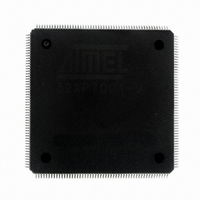AT32AP7001-ALUT Atmel, AT32AP7001-ALUT Datasheet - Page 772

AT32AP7001-ALUT
Manufacturer Part Number
AT32AP7001-ALUT
Description
IC MCU 32BIT AVR32 208-LQFP
Manufacturer
Atmel
Series
AVR®32 AP7r
Specifications of AT32AP7001-ALUT
Core Processor
AVR
Core Size
32-Bit
Speed
150MHz
Connectivity
EBI/EMI, I²C, MMC, PS2, SPI, SSC, UART/USART, USB
Peripherals
AC'97, DMA, I²C, POR, PWM, WDT
Number Of I /o
90
Program Memory Type
ROMless
Ram Size
32K x 8
Voltage - Supply (vcc/vdd)
1.65 V ~ 1.95 V
Data Converters
D/A 2x16b
Oscillator Type
Internal
Operating Temperature
-40°C ~ 85°C
Package / Case
208-LQFP
Data Bus Width
32 bit
Data Ram Size
32 KB
Interface Type
EBI, ISI, MCI, PS2, SPI, TWI, USB
Maximum Clock Frequency
150 MHz
Number Of Programmable I/os
90
Number Of Timers
3
Maximum Operating Temperature
+ 85 C
Mounting Style
SMD/SMT
Minimum Operating Temperature
- 40 C
On-chip Dac
16 bit, 1 Channel
Package
208PQFP
Device Core
AVR32
Family Name
AT32
Maximum Speed
150 MHz
Operating Supply Voltage
1.8 V
For Use With
ATAVRONEKIT - KIT AVR/AVR32 DEBUGGER/PROGRMMRATNGW100 - KIT AVR32 NETWORK GATEWAYATSTK1000 - KIT STARTER FOR AVR32AP7000
Lead Free Status / RoHS Status
Lead free / RoHS Compliant
Eeprom Size
-
Program Memory Size
-
Lead Free Status / Rohs Status
Details
Available stocks
Company
Part Number
Manufacturer
Quantity
Price
Company:
Part Number:
AT32AP7001-ALUT
Manufacturer:
EVERLIGHT
Quantity:
12 000
- Current page: 772 of 829
- Download datasheet (12Mb)
36.4.1.3
36.4.1.4
36.4.1.5
36.4.1.6
36.4.1.7
36.4.2
32015G–AVR32–09/09
AUX-based debug features
OCD Mode
Monitor Mode
Program Counter monitoring
Cyclic Redundancy Check (CRC)
NanoTrace
When a breakpoint triggers, the CPU enters OCD mode, and instructions are fetched from the
Debug Instruction OCD register. Each time this register is written by JTAG, the instruction is
executed, allowing the JTAG to execute CPU instructions directly. The JTAG master can e.g.
read out the register file by issuing mtdr instructions to the CPU, writing each register to the
Debug Communication Channel OCD registers.
Since the OCD registers are directly accessible by the CPU, it is possible to build a software-
based debugger that runs on the CPU itself. Setting the Monitor Mode bit in the Development
Control register causes the CPU to enter Monitor Mode instead of OCD mode when a breakpoint
triggers. Monitor Mode is similar to OCD mode, except that instructions are fetched from the
debug exception vector in regular program memory, instead of issued by JTAG.
Normally, the CPU would need to be halted for a JTAG-based debugger to examine the current
PC value. However, the AT32AP7001 also proves a Debug Program Counter OCD register,
where the debugger can continuously read the current PC without affecting the CPU. This allows
the debugger to generate a simple statistic of the time spent in various areas of the code, easing
code optimization.
The MIU can be used to automatically calculate the CRC of a block of data in memory. The OCD
will then read out each word in the specified memory block and report the CRC32-value in an
OCD register.
The MIU additionally supports NanoTrace. This is an AVR32-specific feature, in which trace data
is output to memory instead of the AUX port. This allows the trace data to be extracted by JTAG
MEMORY_ACCESS, enabling trace features for JTAG-based debuggers. The user must write
OCD registers to configure the address and size of the memory block to be used for NanoTrace.
The NanoTrace buffer can be anywhere in the physical address range, including internal and
external RAM, through an EBI, if present. This area may not be used by the application running
on the CPU.
Utilizing the Auxiliary (AUX) port gives access to a wide range of advanced debug features. Of
prime importance are the trace features, which allow an external debugger to receive continuous
information on the program execution in the CPU. Additionally, Event In and Event Out pins
allow external events to be correlated with the program flow.
The AUX port contains a number of pins, as shown in
plexed with PIO lines, and must explicitly be enabled by writing OCD registers before the debug
session starts. The AUX port is mapped to two different locations, selectable by OCD Registers,
minimizing the chance that the AUX port will need to be shared with an application.
Debug tools utilizing the AUX port should connect to the device through a Nexus-compliant Mic-
tor-38 connector, as described in the AVR32AP Technical Reference manual. This connector
Table 36-1 on page
AT32AP7001
773. These are multi-
772
Related parts for AT32AP7001-ALUT
Image
Part Number
Description
Manufacturer
Datasheet
Request
R

Part Number:
Description:
DEV KIT FOR AVR/AVR32
Manufacturer:
Atmel
Datasheet:

Part Number:
Description:
INTERVAL AND WIPE/WASH WIPER CONTROL IC WITH DELAY
Manufacturer:
ATMEL Corporation
Datasheet:

Part Number:
Description:
Low-Voltage Voice-Switched IC for Hands-Free Operation
Manufacturer:
ATMEL Corporation
Datasheet:

Part Number:
Description:
MONOLITHIC INTEGRATED FEATUREPHONE CIRCUIT
Manufacturer:
ATMEL Corporation
Datasheet:

Part Number:
Description:
AM-FM Receiver IC U4255BM-M
Manufacturer:
ATMEL Corporation
Datasheet:

Part Number:
Description:
Monolithic Integrated Feature Phone Circuit
Manufacturer:
ATMEL Corporation
Datasheet:

Part Number:
Description:
Multistandard Video-IF and Quasi Parallel Sound Processing
Manufacturer:
ATMEL Corporation
Datasheet:

Part Number:
Description:
High-performance EE PLD
Manufacturer:
ATMEL Corporation
Datasheet:

Part Number:
Description:
8-bit Flash Microcontroller
Manufacturer:
ATMEL Corporation
Datasheet:

Part Number:
Description:
2-Wire Serial EEPROM
Manufacturer:
ATMEL Corporation
Datasheet:











